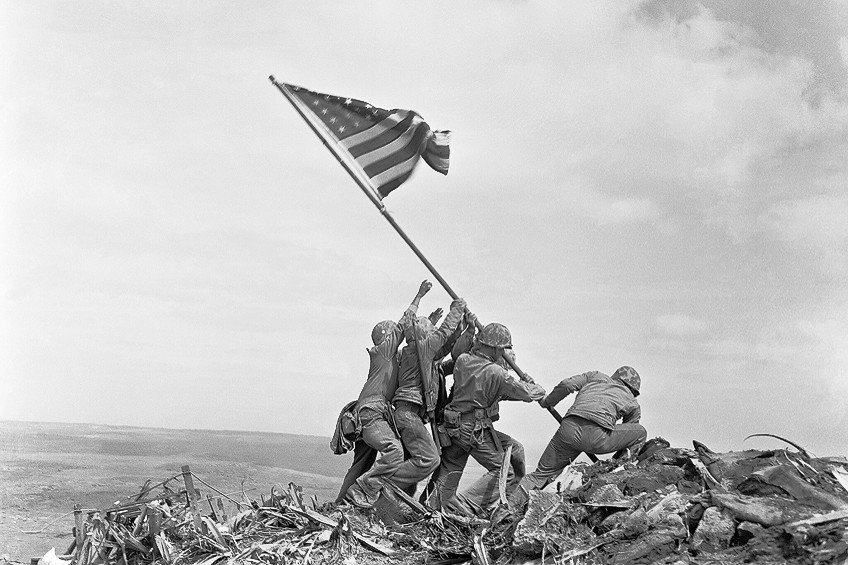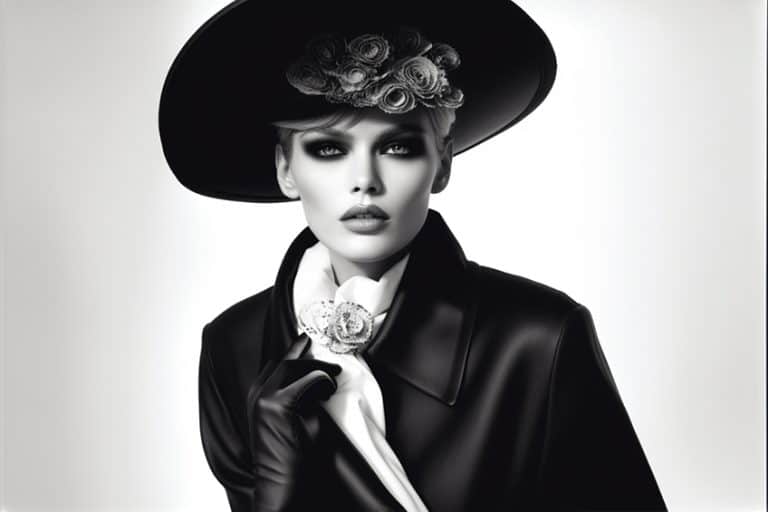Famous Black and White Photos – Timeless Monochromes
Since the invention of the first photographic technique by Nicéphore Niépce in 1822, aspects of the world and society have been captured in black and white. As such, the history of black and white photography includes the works of artists, freelancers, photojournalists, and scientists who sought to document some of the world’s most iconic moments. In this article, we will explore the top 15 most iconic black and white pictures of all time that have been recognized as unforgettable images, famous photos, and historical moments. Keep reading to learn more about what makes black and white photography so timeless, as well as the unique histories of some of the world’s most famous black and white photos.
Table of Contents
- 1 What Makes Black and White Photography So Iconic?
- 2 Black and White Photography in the 20th Century
- 3 Exploring the Top 15 Most Iconic Black and White Pictures
- 3.1 One Times Square, Under Construction (1903) by Unknown
- 3.2 The Steerage (1907) by Alfred Stieglitz
- 3.3 Mother and Child Wearing Gas Masks (1918) by Unknown
- 3.4 Monolith, the Face of Half Dome, Yosemite National Park, California (1927) by Ansel Adams
- 3.5 Casual Lunch Break on Top of a Skyscraper (1932) by Unknown
- 3.6 Behind the Gare St. Lazare (1932) by Henri Cartier-Bresson
- 3.7 Migrant Mother, Nipomo, California (1936) by Dorothea Lange
- 3.8 The Hindenburg Disaster (1937) by Murray Becker
- 3.9 Mushroom Cloud over Nagasaki (1945) by Charles Levy
- 3.10 Raising the Flag on Iwo Jima (1945) by Joe Rosenthal
- 3.11 V-J Day in Times Square (1945) by Alfred Eisenstaedt
- 3.12 Elvis Presley In The Army Photo Archive (1958 – 1960) by AP Wire Service
- 3.13 The Burning Monk (1963) by Malcolm Browne
- 3.14 Muhammad Ali Stands Over Sonny Liston (1965) by John Rooney
- 3.15 Stray Dog, Misawa (1971) by Daidō Moriyama
- 4 Frequently Asked Questions
What Makes Black and White Photography So Iconic?
Since the 19th century, black and white photography has evolved to capture both the historical and artistic moments in life that preserve events, reactions, and faces in history for future generations to look back on. Black and white photography is a classic art form that requires the image to be effective in eliciting an emotional response despite the lack of color. Most famous black and white photographers rely on various photography techniques to achieve the most impactful images in monochrome. These include high clarity, contrast, variation in shape or texture, and compositional framing techniques.
So, what makes black and white photographs stand out, and why are they considered so iconic?
Apart from the many creative techniques and methods to spruce up your black and white photography, such images become particularly iconic if they capture perhaps a fleeting moment that could have never have otherwise been captured at any other point in time. Being present at certain historical events and being able to access the faces and personalities of the world who shape it, make for photos that could be considered timeless. As such, the subject is one of the most important elements of black-and-white images since the background behind each subject comes with more than just a face.

One does not need to have the perfect arrangement of lighting or the latest equipment to shoot impactful black-and-white photos. One can also learn a great deal from famous black and white photographers such as Diane Arbus, Ansel Adams, Gordon Parks, Margaret Bourke-White, Henri Cartier-Bresson, and Dorothea Lange, whose images shaped the course of documentary photography and iconic images of history throughout the 20th century.
Black and White Photography in the 20th Century
The 20th century holds many of the world’s most iconic black-and-white photos and was best known for pioneering photography into the fine art realm. Photography was in the process of undergoing an incredible transformation, from black and white photography to color, and the introduction of the Kodak Brownie around 1900, made photography a practice that was accessible to more people. The 20th century also witnessed the rise of Modernism and postmodernism, which influenced photography through new approaches that celebrated soft-focus visuals. Straight photography in the 1920s was pioneered by famous photographers like Edward Weston and Ansel Adams, whose images highlighted the sharp contrasts and immaculate details of magnificent landscapes and cities.
This primed the base for documentary photography, which thrived without manipulation and editing throughout the Great Depression and in the works of artists like Dorothea Lange.
Of the many popular historic black and white photos are images of war, which saw the rise of photojournalism to capture history in the making. The 1930s and 1940s were important decades for black-and-white photography and visual styles since images of World War II and the Spanish Civil War emerged to stir public opinion and document the atrocities of conflict. Renowned photographers like Margaret Bourke-White and Robert Capa were such figures who captured some of the most impactful wartime photographs in monochrome.
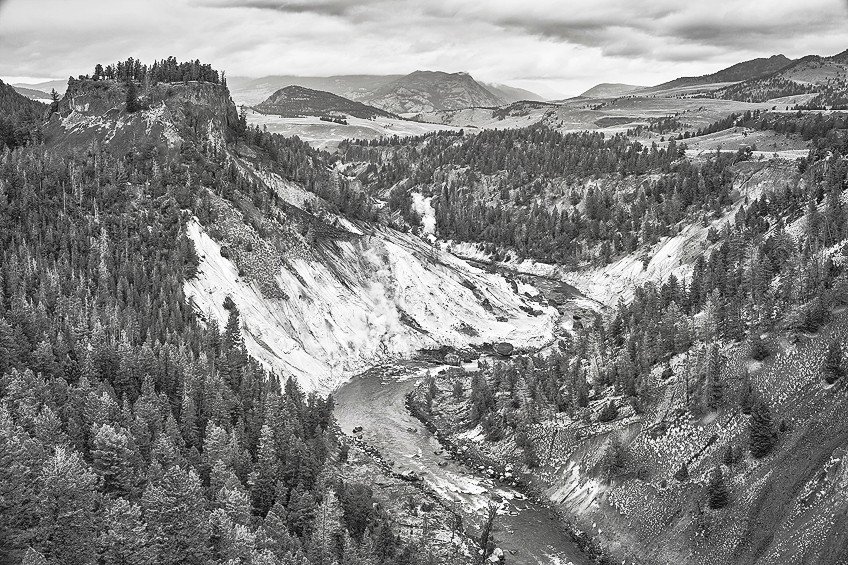
In the post-war era, many photographers, including those affiliated with the Magnum Photos agency, drew attention to Henri Cartier-Bresson’s decisive moment to capture candid and spontaneous moments in everyday life, fashion, and urban environments to capture societal changes. The 35mm film camera also allowed photography to broaden its visual field and encouraged photographers to explore street photography. Toward the latter half of the 20th century, black and white photography had seeped into a genre of its own in fine art and conceptual art through artists such as Cindy Sherman, who propelled the medium as a tool to relay complex narratives about important issues and ideas in 1960s reality.
Experimental photography through solarization and multiple exposures became prominent and added a level of abstract surrealism to monochrome photography.

Since the late 20th century, black and white photography has shifted into the digital photography space to capture moments timelessly while providing ease to photographers when capturing spontaneous moments and staged images. Despite the dominance of color photography, black and white photography still maintains its significance through its emotive power and timeless qualities, aided by the hand of technological advancement to preserve history.
Exploring the Top 15 Most Iconic Black and White Pictures
The first successful monochrome images were shot by Joseph Nicephore Niepce in the early 19th century and were initially destroyed. However, the French developer achieved success again in 1825 and created a new black-and-white photograph that illustrated a window scene. Now that we live in a digital age of color, imagining the world in black and white seems to be a matter of the 20th century. With advancements in photographic equipment and editing software, we can now enjoy the art of black-and-white photography with greater ease than the preliminary techniques from Niepce’s era.
From unseen and remote landscapes to events that shook society at large, below, we have compiled a list of the top 15 most famous historic black and white photos to date.
One Times Square, Under Construction (1903) by Unknown
| Artist Name | Unknown |
| Date | 1903 |
| Medium | Photograph |
| Dimensions (cm) | Unavailable |
| Where It Is Housed | Unavailable |
This is one of the most iconic black-and-white pictures in American history that captures the construction of the New York Times Building at One Times Square, which was to become the headquarters of The New York Times. The building was completed in 1904 and was photographed in its unfinished state by an unknown photographer, whose image remains one of the most famous black and white photos to date. At the time, the building was meant to become New York’s second-tallest skyscraper and was recognized as the Flatiron Building.

The Steerage (1907) by Alfred Stieglitz
| Artist Name | Alfred Stieglitz (1864 – 1946) |
| Date | 1907 |
| Medium | Photogravure |
| Dimensions (cm) | 33.4 × 26.4 |
| Where It Is Housed | The J. Paul Getty Museum, Los Angeles, United States |
This famous black and white photogravure is recognized as one of the most famous black and white photographs of all time that was captured by Alfred Stieglitz in 1907. Inspired by a scene that fascinated Stieglitz, the photo was composed by Stieglitz’s curious eye that spotted shapes that he identified as complementary to each other. Stieglitz had still been able to recall his experience of spotting the image that was created when he detoured from his first-class deck to observe the lower steerage area that was crowded with passengers.

He quickly identified the stark contrast in conditions as compared to the rich “first class” section that he just left behind. His suppressed composition reminds one of the bustling environment of the economic level and captures the scene on more than just a visual level.
Mother and Child Wearing Gas Masks (1918) by Unknown
| Artist Name | Unknown |
| Date | 1918 |
| Medium | Photograph |
| Dimensions (cm) | Unavailable |
| Where It Is Housed | The British Library, public domain |
This image of a mother holding her child securely in her arms as the two equip themselves with gas masks is a haunting moment of history’s darker era and one of the most famous historic black and white photos. The mother is busy cooking on an open fire and remains in one’s mind as a snapshot of the dangers of civilian life in World War I. The image is a reminder of the chemical weapons used by the German army and became a symbol of the dehumanization of such tactics. The technological developments of the First World War also saw advancements in gas warfare, which required civilians to be on guard in case of an attack.

The masks that the woman and her child are wearing in the image were identified as British-issued and had already become obsolete two years before the image was taken. In the same year, the Germans invaded the Allies’ lines at the Kaiserschlacht, which meant that civilians may have been issued these obsolete masks that were adapted by tucking them into a jacket to prevent gas entry. It is also speculated that this photograph was perhaps staged to evoke an emotional response from the world and showcase the harm to innocent civilians.
Monolith, the Face of Half Dome, Yosemite National Park, California (1927) by Ansel Adams
| Artist Name | Ansel Adams (1902 – 1984) |
| Date | 1927 |
| Medium | Gelatin silver print (printed 1974) |
| Dimensions (cm) | 49.6 x 37.1 |
| Where It Is Housed | The Metropolitan Museum of Art, New York City, United States |
Created in 1927 as part of Ansel Adams’ series on the High Sierras, this famous black and white photo is one of the photographer’s most famous images. Ansel Adams was widely celebrated as one of the 20th century’s most famous black and white photographers who captured the western front of the Yosemite Half Dome in California.

The image is visually strong as it draws attention to the detail and texture of the natural rock surface, as well as the pine trees in the backdrop showcasing the landscape of Tenaya Peak. Adams was recognized as a leader in environmental photography whose image was used by the Sierra Club to represent the environmental movement. It was also the first image shot by Adams that alluded to his feelings as part of the image’s concept and was a form of visualization that enabled him to create the Zone System.
Casual Lunch Break on Top of a Skyscraper (1932) by Unknown
| Artist Name | Unknown |
| Date | 1932 |
| Medium | Photograph |
| Dimensions (cm) | Unavailable |
| Where It Is Housed | New York Herald Tribune archive |
Originally misattributed to Charles Ebbets and Lewis Hine, this famous photograph was shot in 1932 by an unknown photographer, who captured a scene with 11 ironworkers seated on a beam on the 69th floor of the RCA building in New York City. The image was dubbed as a piece of American history that showcases the contributions of immigrants who toiled in dangerous conditions to build iconic structures in New York. Today, the image holds its title as the most famous picture of a lunch break during the Great Depression that has since been colorized.
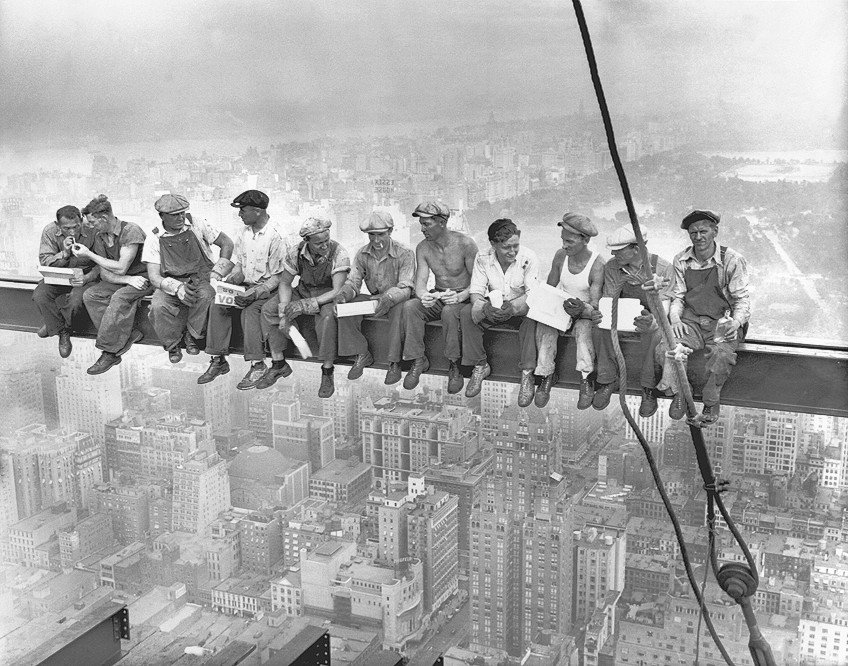
Behind the Gare St. Lazare (1932) by Henri Cartier-Bresson
| Artist Name | Henri Cartier-Bresson (1908 – 2004) |
| Date | 1932 |
| Medium | Gelatin silver print (printed c. 1950s) |
| Dimensions (cm) | 35.2 x 24.1 |
| Where It Is Housed | The Museum of Modern Art, New York City, United States |
Place de l’Europe Gare Saint Lazare is an iconic photo by filmmaker and black-and-white photographer Henri Cartier-Bresson who shot this playful scene in 1932. The image captures a moment right before the man’s foot touches the puddle of water. The striking image mimics the image of a ballet dancer leaping in the air and is richly packed with a combination of interesting visual elements such as reflections, curves, and lines, in addition to the anticipation of the scene. The dynamism of the man’s stride also inspired the poster for the Railowsky circus.

Migrant Mother, Nipomo, California (1936) by Dorothea Lange
| Artist Name | Dorothea Lange (1895 – 1965) |
| Date | 1936 |
| Medium | Gelatin silver print |
| Dimensions (cm) | 28.3 x 21.8 |
| Where It Is Housed | The Museum of Modern Art, New York City, United States |
This unforgettable image of a migrant mother and her children at a pea-picking camp in California during the Great Depression. The image titled Migrant Mother, Nipomo, California was shot by renowned black and white photographer Dorothea Lange in 1936 and later became a subject of controversy because the photo became so widely published and praised without the identification of the woman in the photo.

Lange photographed the image while on an assignment for the Farm Security Administration program that was aimed at helping impoverished farmers and families. The woman in the photo was said to resemble the iconographic image of Mary and her children, which piloted Lange to fame. Her name was Florence Owens Thompson, who claimed that Lange perhaps embellished her story to enhance the narrative of the image.
The Hindenburg Disaster (1937) by Murray Becker
| Artist Name | Murray Becker (1909 – 1986) |
| Date | 1937 |
| Medium | Photograph |
| Dimensions (cm) | Unavailable |
| Where It Is Housed | Unavailable |
In March 1937, New Jersey witnessed an aircraft disaster of a German commercial airship that was designed by the Zeppelin Company and caught fire during its attempt to dock. The airship went down in flames with 35 casualties and 97 passengers on board. The disaster signaled the end of the airship era and the public’s trust in the company. One of the eyewitnesses was the photographer Murray Becker, who captured the fire exploding out of the ship as it crashed to the ground on May 6. The ship was named after the German President Field Marshal Paul von Hindenburg and had previously embarked on trips to the United States and Brazil before crashing in New Jersey.
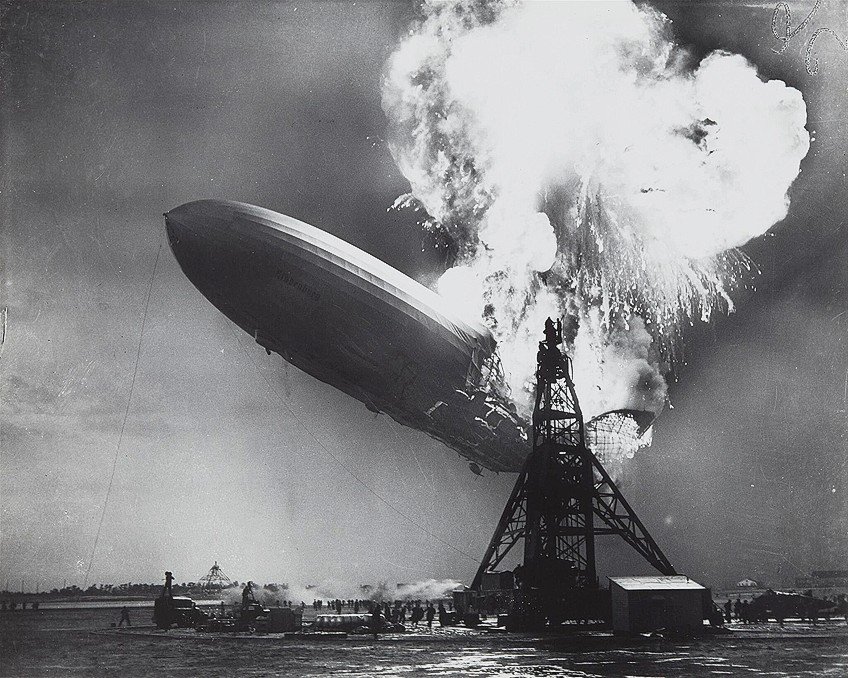
Mushroom Cloud over Nagasaki (1945) by Charles Levy
| Artist Name | Charles Levy (1918 – 1997) |
| Date | 1945 |
| Medium | Photograph |
| Dimensions (cm) | Unavailable |
| Where It Is Housed | Unavailable |
This famous historical image is perhaps one of the greatest black-and-white photos that is one of its kind in terms of subject and location. The photograph of the humongous mushroom cloud emanating from the drop site at Nagasaki was photographed from a bomber craft by the Lieutenant of the United States Air Force in 1945. The photographer, Charles Levy, captured what was to be the death of more than 70,000 people in the city followed by many additional injuries and deaths from the aftermath. The atomic bomb was dubbed Little Boy as it carried around 64 kilograms of uranium to destroy Nagasaki.

Japan was already reeling from the previous bomb that was dropped on Hiroshima just three days earlier. As such, the horrifying image disturbs one more emotionally as one learns more about the image and context of the subject. According to those who first saw the mushroom cloud in color, it resembled “boiling coffee” with hues of all colors in “purple, white, and red”.
Raising the Flag on Iwo Jima (1945) by Joe Rosenthal
| Artist Name | Joe Rosenthal (1911 – 2006) |
| Date | 1945 |
| Medium | Photograph |
| Dimensions (cm) | Unavailable |
| Where It Is Housed | Unavailable |
This Pulitzer Prize-winning image is one of the most famous black and white pictures of World War II that was shot by Joe Rosenthal as part of the Associated Press in 1945. The image is regarded as an iconic black-and-white picture that shows six marines raising the United States flag on Iwo Jima at Mount Suribachi. The photo was captured on 23 February, just a week after the troops landed in the region. The image captured the final moments of the Pacific War that was first published two days after it was shot in the Sunday newspapers and was then widely distributed across the world.
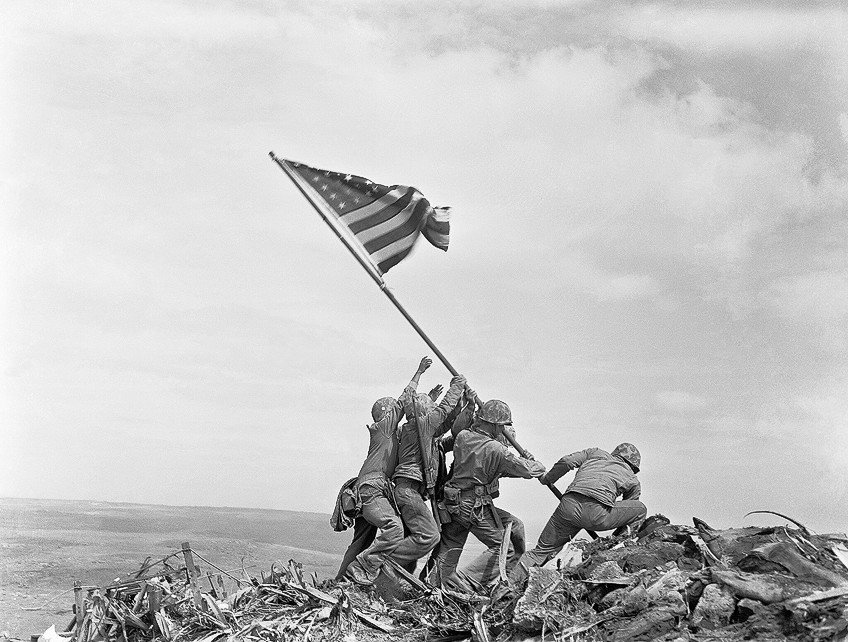
In 1945, it was also the only image to win the Pulitzer Prize in the same year that it was published and was later used in 1954 for the Marine Corps War Memorial sculpture, created by Felix de Weldon. Since the debut of photography, Rosenthal’s career had skyrocketed, thus expanding his reputation as a talented black-and-white photographer who captured the essence of the war through a single image. He went on to document the postwar period and further helped chronicle history to reveal the resilience of the human spirit, the sacrifice of soldiers, and the moments of the war that sparked solidarity.
V-J Day in Times Square (1945) by Alfred Eisenstaedt
| Artist Name | Alfred Eisenstaedt (1898 – 1995) |
| Date | 1945 |
| Medium | Gelatin silver print |
| Dimensions (cm) | 50.8 × 40.6 |
| Where It Is Housed | Gallery M, Denver, Colorado, United States |
This famous black-and-white photograph has been contested over the duality of what its subject conveys. Originally shot as a photograph of a sailor’s celebration of V-J day in Times Square, better known as “Victory over Japan”, this iconic image captured a spur-of-the-moment kiss given to a woman later identified as Greta Zimmer Friedman, by a sailor. The moment was photographed by German-American photojournalist Alfred Eisenstaedt, who was working for Life magazine at the time.

The image has since been criticized as an example of the normalization of sexual assault due to the forceful nature of the kiss, however, the woman in the image, Friedman, did not view it as such and interpreted it as the sailor’s act of celebration rather than a romantic moment. Despite the dual nature of the image, the photo has remained an iconic moment for America that signaled the end of the war. Eisenstaedt was known to photograph many famous images of the 20th century, from politicians to street scenes and artists, using only a 35mm camera and his keen eye.
Elvis Presley In The Army Photo Archive (1958 – 1960) by AP Wire Service
| Artist Name | AP Wire service |
| Date | 1958 – 1960 |
| Medium | Photography |
| Dimensions (cm) | 20.3 x 25.4 |
| Where It Is Housed | Private collection |
These famous black and white photos of Elvis Presley in the United States Army is among the most well-known collection of Presley photos that are considered rare. This collection was sold at Sotheby’s on auction for just over a low $500 in 2004 and features images of Presley in the army, donned in his full uniform, and in many scenes that were previously unseen. The collection was provided by the AP Wire service and their many press blurbs from the time Elvis Presley joined the army around 1958.

Presley had also engaged in overseas army activities in October of 1958 when he left for Germany for basic training until 1960. Elvis Presley was an icon of the 20th century, who was best recognized as the “King of Rock and Roll” whose stage presence was electrifying to many who admired the fusion of country, rock, and blues. What makes his images so powerful is that he was a symbol of rebellion in America and pop culture that appealed to both the young and old. His influence also extended to popular films that shaped a part of American popular culture and entertainment.
The Burning Monk (1963) by Malcolm Browne
| Artist Name | Malcolm Browne (1931 – 2012) |
| Date | 1963 |
| Medium | Photography |
| Dimensions (cm) | Unavailable |
| Where It Is Housed | Unavailable |
This shocking image was photographed by American journalist Malcolm Brown in 1963, which won him a Pulitzer Prize for International Reporting. The image captures the horrific act of self-immolation by a monk named Thích Quảng Đức in 1963 at an intersection in Saigon Road. The image is famous since it is one of the most chilling photos on the internet that narrates the story of a monk, who was perhaps part of an arranged suicide. At the time, Brown was photographing in central Vietnam and happened to hear of a story that the monks were planning a protest, which would involve a shocking act of self-immolation or the disembowelment of one of the monks.
With no way to identify if this was an empty promise and many choosing to ignore the threats of the monks, Brown showed up at the site and photographed a scene that no one believed would have occurred.
According to an interview with Brown, he was the only one who thought that the monks were going to pull off something spectacular. In the days leading up to the immolation, Brown also recognized funeral chants at the pagoda, as though the monks were preparing for the death of a monk. Malcolm Browne’s photography was defined by his documentation of the Vietnam War and many significant events in between that shed light on the conflict and exposed various narratives within the war.

His photos revealed the harsh realities of those affected by the war, from physical suffering to emotional pain. At the forefront of his images was the power of brutality and the resilience of Vietnamese people during the harsh political climate. By studying his works, one is also reminded of the costs of war and the impact that the Vietnam War had on innocent civilians.
Muhammad Ali Stands Over Sonny Liston (1965) by John Rooney
| Artist Name | John Rooney (n.d.) |
| Date | 1965 |
| Medium | Photograph |
| Dimensions (cm) | Unavailable |
| Where It Is Housed | AP Photo Archive |
Cassius Clay, also known as Muhammad Ali, was once the world’s heavyweight champion and a celebrated figure of boxing, who triumphed over Sonny Liston on 25 May 1965. This iconic black and white photo was photographed by Associated Press photographer John Rooney alongside Neil Leifer to capture one of the world’s most famous images of the sport. According to the story, it was the duo’s second encounter in a match, which won Ali his title.
![Muhammad Ali vs Sonny Liston II (1965) [FULL FIGHT]](https://i.ytimg.com/vi/X8DR0P0PV5c/hqdefault.jpg)
Liston was already an established ring champion, who was renowned for his intimidating physicality and technique, however, Ali, who had received less cheer than Liston, managed to floor the seasoned boxer in what would become one of the greatest sports images in history. Before Ali took on Liston in his second match, Ali made it known to the public that he changed his name to Muhammad Ali and was even considered to be in potential danger of assassination after the assassination of Malcolm X in that same year. His new persona was not welcomed by many Americans, resulting in more favor for Liston leading up to the iconic match.
Stray Dog, Misawa (1971) by Daidō Moriyama
| Artist Name | Daidō Moriyama (1938- Present) |
| Date | 1971 |
| Medium | Gelatin silver print |
| Dimensions (cm) | 43.2 x 58.5 |
| Where It Is Housed | Private collection |
Stray Dog, Misawa is one of the most famous black and white photos that was taken by the renowned Japanese artist Daido Moriyama in 1971. The image reflects Moriyama’s subversive visual language that uses high contrasts to capture his experience of his homeland throughout the 1960s and 1970s. The way that his images are shot is also reminiscent of stylized Contemporary visuals that incorporate saturated and grainy textures to give his work a distinct look and feel. Since the 1970s, Moriyama has remained one of the most iconic photographers whose approach to black-and-white photography stirs up a sense of intrigue, mystery, and chaos within the nostalgic and unseen chaos of black-and-white grainy photography.

Moriyama’s contributions to street photography are further defined by his use of high contrast and poetic visuals that evoke his experience of Tokyo. Through tilted horizons and stark shadows, Moriyama draws attention to everyday subjects such as the dog in this photo to portray the visceral atmosphere of the city and modern society. One is forced to confront the stray dog and question its fate in a society that presents harsh realities for those who cannot fend for themselves.
By appreciating the past from the monochrome lenses of famous photographers of the 20th century, you can begin to understand the essentials of capturing raw moments that have the power to define an event. These top 15 famous black-and-white photos offer us a glimpse into the past that is devoid of vibrancy, yet jam-packed with emotion through the documentation of history, cultural shifts, and experiences that unite generations. The beauty of black and white photography is thus highlighted in its timeless elegance that encourages us to introspect on the past and the significance behind the absence of color.

Take a look at our black-and-white photos webstory here!
Frequently Asked Questions
What Is the Most Famous Black and White War Photograph?
Mushroom Cloud over Nagasaki (1945) by Charles Levy is regarded as the most famous black and white war photograph that captured the mushroom cloud towering over Nagasaki, where the second atom bomb was dropped. The blast killed more than 70,000 people.
What Is the Most Famous Black and White Picture from the Civil Rights Movement?
Rosa Parks Being Fingerprinted, Montgomery, Alabama (1956) was photographed by an unknown photographer and is a documentation of the renowned Civil Rights activist Rosa Parks being fingerprinted at her second arrest. After she refused to relinquish her seat on a bus in 1955, she inspired a boycott of city buses, which sparked the nationwide recognition of the civil rights movement. This image was widely distributed at the time, making it one of the most famous black-and-white pictures from the civil rights movement.
Who Photographed the First Black and White Image?
Joseph Nicéphore Niépce was credited with photographing the first black-and-white image in 1826. His image captured a view from his window and was previously successful before 1825, however, the original black and white image was reportedly destroyed in a fire.
Jordan Anthony is a film photographer, curator, and arts writer based in Cape Town, South Africa. Anthony schooled in Durban and graduated from the University of the Witwatersrand, Johannesburg, with a Bachelor of Art in Fine Arts. During her studies, she explored additional electives in archaeology and psychology, while focusing on themes such as healing, identity, dreams, and intuitive creation in her Contemporary art practice. She has since worked and collaborated with various professionals in the local art industry, including the KZNSA Gallery in Durban (with Strauss & Co.), Turbine Art Fair (via overheard in the gallery), and the Wits Art Museum.
Anthony’s interests include subjects and themes related to philosophy, memory, and esotericism. Her personal photography archive traces her exploration of film through abstract manipulations of color, portraiture, candid photography, and urban landscapes. Her favorite art movements include Surrealism and Fluxus, as well as art produced by ancient civilizations. Anthony’s earliest encounters with art began in childhood with a book on Salvador Dalí and imagery from old recipe books, medical books, and religious literature. She also enjoys the allure of found objects, brown noise, and constellations.
Learn more about Jordan Anthony and the Art in Context Team.
Cite this Article
Jordan, Anthony, “Famous Black and White Photos – Timeless Monochromes.” Art in Context. October 30, 2023. URL: https://artincontext.org/famous-black-and-white-photos/


